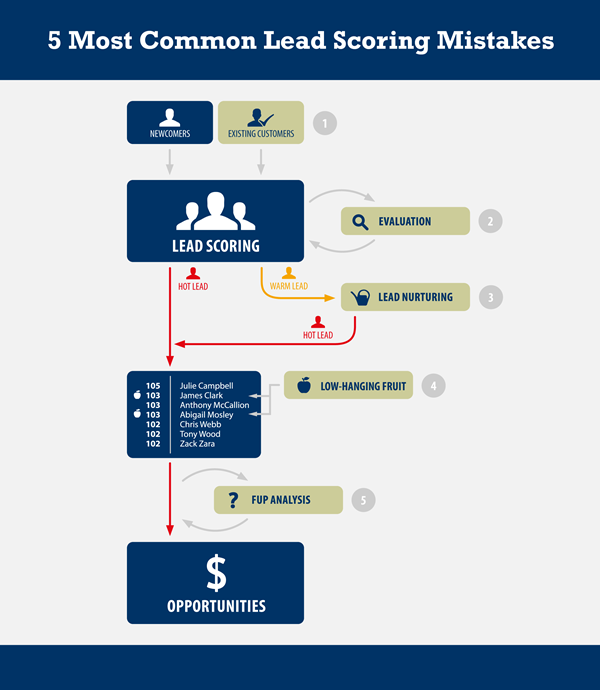The 5 Most Common Lead Scoring Mistakes
Each lead scoring implementation is unique and depends on many variables, yet all are prone to common mistakes and omissions.
These are the top five mistakes in
lead scoring usage as discovered during 3 years of working with lead scoring, both from the experiences of our customers and our own company efforts.
1. “Our lead scoring system helps us to identify the best prospects and opportunities.”
Sure, but have you considered your current customers in your lead scoring system too?
While lead scoring is mainly used to score newcomers, your current customers shouldn’t be forgotten. Existing clients may come back to your website searching for an upgrade, additional services or even something new. There are different ways to get these customers back onto your lead scoring radar depending mostly on the way your sales reps process the leads and on the average length of your sales cycle. Be sure you don’t miss out on your least costly opportunity — your current clients!
2. “We set up our lead scoring based on industry best practices and used an agile testing approach ahead of implementation. It couldn’t be better!”
You’ve done a great job. Now — are you constantly evaluating your lead scoring rules?
Even if your lead scoring rules were established in tight cooperation with sales and you went through a number of iterations with pilot versions, it’s still crucial to have an ongoing evaluation process in place that allows you to fine-tune your lead scoring over time. Sales reps should be able to rate each followed-up lead on a scale. Then correlation analysis between this rating and the leads’ data can reveal the reliability of the current scoring rules and might lead to significant changes in it.
3. “We are now not just focusing on delivering a high number of leads, but the hottest ones.”
Great! Do you have solid lead nurturing in place for those who fall below your definition of a hot lead?
Sales are hungry for the hottest leads, those closest to the actual sale and marketing is focused on delivering the highest number of these. But neglecting those not quite hot enough is a tragic waste of deal potential (and marketing campaign dollars). With a solid lead nurturing program that delivers great content and a high level of personalization, you might double your hot leads without spending a cent more on your campaigns.
4. “Our sales team works from a healthy pipeline of leads listed by score.”
Good for you and for sales. Does your sales team have the ability to quickly spot the important details within this BIG data?
Lead scoring counts the scores of every lead and lists them in point order, so that the hottest ones can be easily found and contacted. This can be a very long list of leads and may have your HR department drafting job adverts for additional Sales reps.
Why not “decrypt” this Big Data, making leads easy to scan through by using specific flags or icons related to prospect activity and interests — for example, website visitors who have performed an internal site search? Flagging helps quickly identify those leads in the list suitable for content personalization. Sales can quickly and easily move along with follow up contact and the next steps that will make sense for prospects.
5. “Thanks to lead scoring we experienced 28% YOY quarterly growth in valuable leads.”
Sounds promising. Do you also track the follow-up ratio on these leads?
You have a healthy pipeline of leads and your lead scoring is working well, providing your sales team with sales-ready leads. But what happens to your leads once they are processed by sales? How many of them have been followed up and by which method (phone, email, personal meeting, etc.)? Is the lead pipeline fairly distributed among your sales offices? Is every sales rep able to follow up in a timely manner?
Constant analysis and reporting on lead follow-ups will help you to answer these questions and ensure that your marketing and sales efforts are well aligned and productive.
Asking the questions listed above should help you take appropriate action in leveraging hidden opportunities and tuning your lead scoring to perfection, resulting in improved and highly efficient sales processes — all to boost your ROI, company revenue and the successful collaboration of sales and marketing for better outcomes.
Click on the image to see a full-size version.
